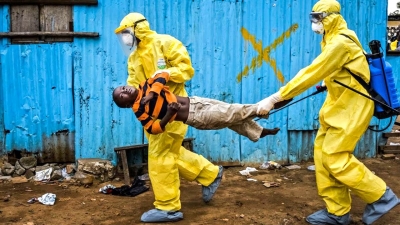What is Ebola?

In September 2022, Uganda announced its first Ebola fatality since 2019 in an outbreak in the central district of Mubende. But what is Ebola, what causes it, and what are its symptoms? Come, let’s find out….
Ebola is a rare, deadly viral haemorrhagic fever. It was first discovered in the Democratic Republic of Congo (formerly Zaire) in 1976. DR Congo has experienced 14 Ebola outbreaks since then. There are different strains of the virus that are known to affect people. They include Zaire, Sudan, Bundibugyo, Reston and Tai Forest. Death rate among the Ebola-infected people is high ranging up to 90 % in some outbreaks, according to the World Health Organisation.
Spreads from fruit bats?
A species of fruit bat is said to be the most likely source of the disease. People get exposed to the virus if they touch the skin or body fluids of infected bats It's interesting to note that the infected bats themselves do not fall ill. But how does the virus spread among humans? It is through contact with the blood, body fluids, or secretions of an infected person or one who has just died from the disease. It is said that outbreaks are difficult to contain as people who are infected do not become contagious until symptoms manifest. High contagiousness occurs soon after their deaths, say, during funeral services.
Symptoms of Ebola
The Ebola virus has an incubation period of 2-21 days. High fever, fatigue, severe muscle and joint pain, headache, and sore throat are initial symptoms. As the disease progresses, the virus damages the immune system as well as the organs. Hence, the initial symptoms are often followed by vomiting, diarrhoea, skin eruption, kidney and liver failure, and sometimes internal and external bleeding.
Treatment
Ebola can be diagnosed through tests of blood and tissues. If infection is confirmed in an individual, they should be immediately isolated to prevent the spread of the disease. Currently, there is no cure for Ebola. Two drugs, Inmazeb and Ebanga, have been approved for treating Ebola. Besides, fluids and electrolytes are administered either orally or intravenously, and medications are given to control fever, vomiting, diarrhoea, and other symptoms. Blood transfusions from survivors are done to improve survival. At present, there is the Ervebo vaccine, which is found to be highly effective against the Zaire strain. This is the first Ebola jab approved by the U.S. Food and Drug Administration in December 2019.
QUICK FACTS
* Ebola gets its name from the Ebola River, which is near one of the villages in the DR Congo where the disease first surfaced.
*The worst Ebola epidemic in West Africa between 2013 and 2016 killed more than 11,300 people.
*The DR Congo has had more than a dozen epidemics, the deadliest killing 2,280 people in 2020.
Picture Credit : Google